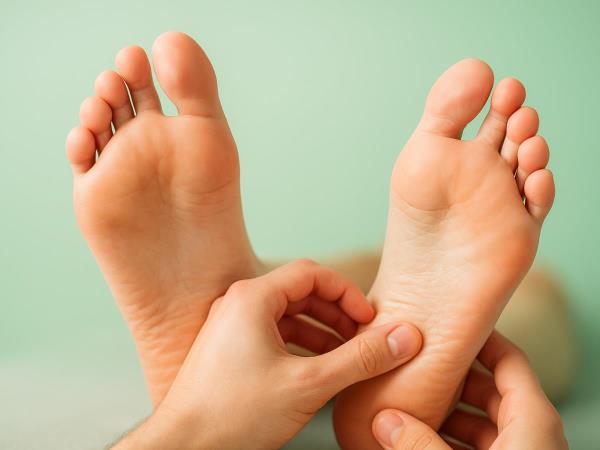- Cold feet and hair loss can signal heart issues
MPA seemingly unusual connection, but if you suddenly notice that your feet are often cold or that you are losing hair on your toes, it may be a sign that blood circulation is not as it should be. The condition, known as peripheral arterial disease (PAD), means that the veins in your legs are partly blocked, similar to a pipe slowly clogging due to limescale buildup, resulting in weaker flow.
If blood doesn't reach your feet, they cool down, and the skin becomes smooth and shiny. A 2021 study by the British National Health Service found that people with PAD have twice the risk of heart attack. Therefore, a note of caution: if your feet are always icy, even when wearing warm socks, it could be a sign that something is amiss in your body. - Non-healing foot wounds could be linked to diabetes
If you notice a wound on your foot that lasts for weeks and doesn't heal, it could be a sign of diabetes. This condition occurs when there is too much sugar in the blood. Over time, this excess damages nerves, sometimes leading to no sensation of pain in the foot even when there is a wound present.
Statistics from 2022 indicate that around 5% of people with diabetes develop foot ulcers. One of these wounds can quickly become infected and in 1% of patients even lead to amputation. That's why doctors advise people with diabetes to check their feet daily.
If along with this you also notice frequent thirst, frequent urination, fatigue, or blurred vision, these combinations of symptoms are a clear sign not to ignore. - Cold and heavy feet could be a sign of thyroid issues
The thyroid is a small gland in the neck that acts as the conductor of the body – coordinating energy, heat, and metabolism. If it is not functioning properly, it's called hypothyroidism (simplified: an underactive thyroid).
When the thyroid doesn't produce enough hormones, the body starts to slow down – metabolism slows, fats are processed less effectively, and energy levels drop. Cold feet are one of the first signs, often accompanied by swollen ankles and fatigue.
A 2020 study from the USA showed that as much as 12% of adults in the developed world have a mild form of hypothyroidism, with many people being unaware of it. If in addition to cold feet, you notice constipation, unexplained weight gain, or constant drowsiness, this is a sign that it would be wise to check your thyroid function. - Yellow and thickened nails often signify a fungal infection
If the nails on your feet are yellowish, thickened, and brittle, it is often due to a fungal infection. In everyday terms, this is commonly known as athlete's foot. These are small fungi that thrive in moist and dark environments – tight shoes, sweaty socks, and lack of airflow provide ideal conditions for their development.
Data from the World Health Organization (WHO) in 2023 indicates that nearly 20% of people worldwide struggle with this infection, especially those who frequently wear closed footwear. The good news is that this condition can often be successfully treated with simple home remedies: washing the feet with saltwater, applying natural tea tree oil (tea tree oil has been used for centuries as an antifungal agent), and avoiding tight shoes. - Unusually large big toe and severe pain can indicate gout
Gout is a specific form of arthritis (inflammation of the joints) that often occurs in the big toe. If your big toe suddenly swells, turns red, and is throbbing with pain, these are classic signs. The cause is an excess of uric acid in the blood – this starts to accumulate in the joints and causes pain.
In the past, gout was dubbed the disease of kings, as it was associated with rich foods and wine. Today, an increasing number of people are affected due to modern diets rich in meat and sweet beverages. According to the European League Against Rheumatism in 2025, 3-4% of adults already have gout, and the numbers are rising.
If left untreated, gout can lead to not only painful joints but also kidney stones. Therefore, it's advisable to watch your diet: less alcohol, less red meat, more vegetables, and plenty of water consumption, as water helps flush out excess acid from the body. - Spoon-shaped nails may indicate anemia
If the nails on your feet are thin, brittle, and slightly curved upwards, it could be a sign of anemia. This condition means there are too few red blood cells in the blood or that they don't contain enough iron to effectively carry oxygen.
An iron-deficient body becomes tired, weak, and often pale. The European Hematology Association data shows that around 20% of women and 8% of men in Europe are iron deficient. The causes vary, with menstruation or pregnancy being common in women, while poor diet can be a factor for everyone.
The good news is that the body stores iron from food. Excellent sources include legumes, red meat, pumpkin seeds, and beets. In traditional medicine, the advice often includes beetroot juice with a little honey, and interestingly, a 2022 study in Germany showed that regular consumption of this juice actually raises iron levels in most people within two months.
How to take care of your feet at home?
Feet are the foundation of our body. They carry us an average of 8,000 steps a day and cover a distance in life equivalent to almost 5 orbits around the Earth. Hence, it's not surprising that they often reveal the first warning signs.
A simple home ritual known since our grandmothers' time is soaking your feet in warm salty water. This relaxes the muscles, disinfects minor wounds, and prevents fungal infections. Regular toenail trimming, wearing cotton socks, and rotating footwear (so it can dry) can prevent most issues.
However, if you notice wounds that aren't healing, severe pain in your big toe, or nail changes that persist for months, it's a good idea to consult a doctor. It's better to act early than late.
Feet as a mirror of your health
Feet are often overlooked, yet they can tell us more than we might think. Cold feet may reveal heart or thyroid issues, unhealed wounds may indicate diabetes, yellow nails on fungus, a swollen big toe on gout, and spoon-shaped nails on iron deficiency.
If you recognize the signs in time, you can prevent more serious problems and improve your health with small, home-based changes.
Therefore, feet are not just a part of the body we hide in shoes. They are a mirror of our health, and by listening to them, you may discover a problem before it becomes more significant.









 Would you like to be informed about news on the website?
Would you like to be informed about news on the website?

